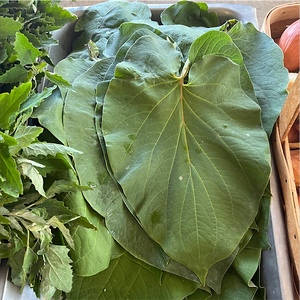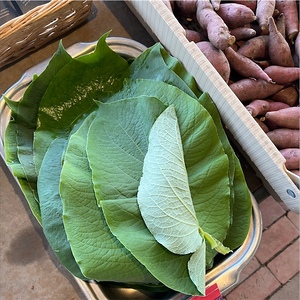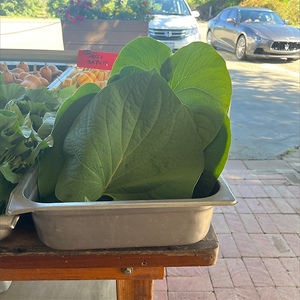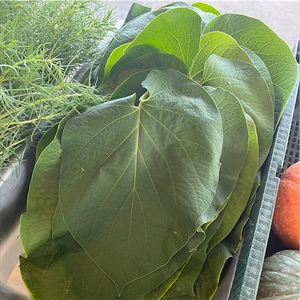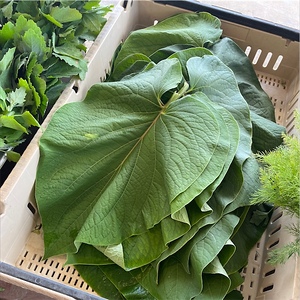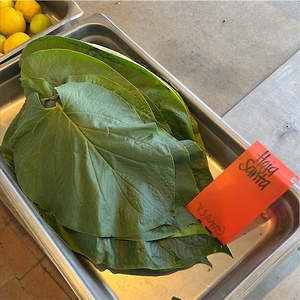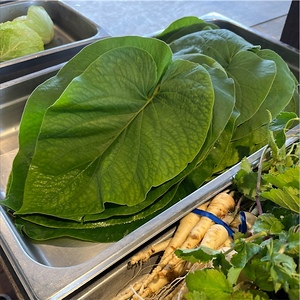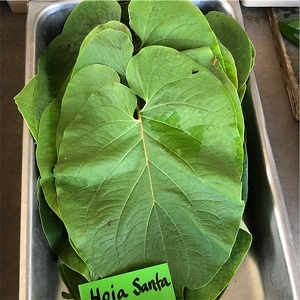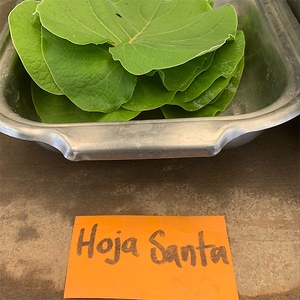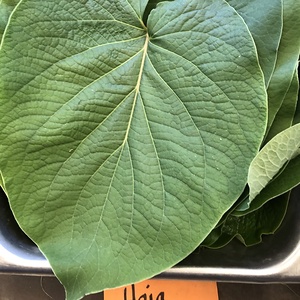

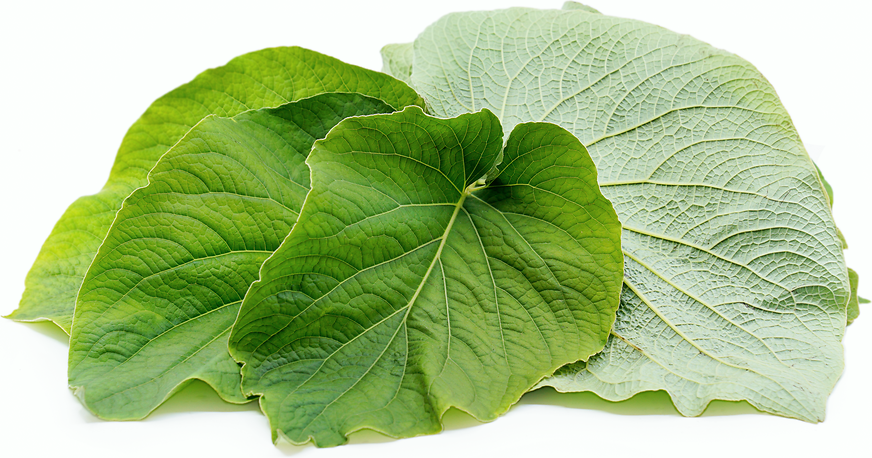
Hoja Santa Leaves
Estimated Inventory, lb : 3.50
This item was last sold on : 07/20/25
Description/Taste
Hoja Santa is a large, hardy perennial herb that can grow up to one meter tall. The broad, floppy, aromatic heart-shaped leaves grow horizontally on thick stalks and can reach 30 centimeters or more in diameter. They are bright green on top with a pale green underside, and they have a velvety texture with slightly rippled edges that taper to a point. Hoja Santa leaves offer a unique, peppery aroma and a complex flavor that is often compared to root beer, with notes of sassafras, anise, tarragon, mint, eucalyptus, nutmeg, and licorice.
Seasons/Availability
Hoja Santa leaves are available year-round.
Current Facts
Hoja Santa leaves are botanically classified as Piper auritum and are members of the Piperaceae, or pepper family. The name Hoja Santa translates from Spanish as "sacred leaf,” but its common nickname in English—especially in the Southern United States—is Root Beer Plant, thanks to its aroma and flavor being reminiscent of sassafras, the traditional essential flavoring agent for root beer soda. Hoja Santa goes by many other monikers, including Mexican Pepperleaf, Sacred Pepper, False Kava, and Yerba Santa, not to be confused with plants in the genus, Eriodictyon, which share the same name.
Nutritional Value
Hoja Santa leaves contain naturally-occurring phytochemicals that have medicinal benefits and are said to have diuretic and anesthetic properties. Hoja Santa leaves were used by the Aztecs as a digestive aid, stimulant, pain reliever, and topical treatment for skin irritations and were even employed to treat bronchial infections and asthma. Hoja Santa leaves contain some of the same aromatic essential oils found in sassafras, most notably safrole, which explains their similarity in smell. It is important to note that safrole was found to be carcinogenic in animals, and its use in commercial food products was banned in the United States in 1960. Root beer has since been produced with artificial sassafras or safrole-free sassafras. However, plants with naturally occurring safrole, including Hoja Santa, sassafras, cinnamon, and basil, contain only small amounts of the chemical compound and are unlikely to cause any harm when consumed in moderate quantities. After all, Hoja Santa has been eaten for centuries throughout Central and South America.
Applications
Hoja Santa leaves are best suited for using fresh in cooked applications like boiling, frying, and sautéing. The veins of the leaves are typically too tough to be eaten raw, but when cooked, the leaves become tender while retaining their flavor and vibrant green color. Hoja Santa leaves are widely used in Mexican cuisine and are an essential ingredient in mole amarillo and mole verde, two seasoning pastes originating in the Oaxaca region of Mexico. In Yucatán, they are a key ingredient in a green liquor called Verdín, and in central Mexico, they are used to flavor chocolate drinks, as was traditional of ancient Aztecs. They are also a common ingredient in Veracruz sauce, made with olive oil, tomato, garlic, white wine, capers, olives, green chiles, parsley, cilantro, and butter. Chopped Hoja Santa is incorporated in a wide variety of Mexican stews and sauces, like pozole, and may also be used to flavor egg dishes. Fresh Hoja Santa leaves are popularly used to wrap and flavor artisanal cheeses or wrap meats and fish for steaming or baking. To use as a wrapper, slice down both sides of the central vein, and use the two lobes to wrap the filling. Hoja Santa leaves can even be used in place of banana leaves or corn husks in tamales, with the added bonus that they do not need to be removed and can be eaten along with the filling. They pair especially well with cilantro, lime, garlic, chile peppers, and tomatillos and can even be used in sweet applications, such as imparting flavor in ice cream or panna cotta. Hoja Santa leaves may also be used dried, however, drying removes much of their taste and makes the leaves too weak to use as a wrapper. Store fresh Hoja Santa leaves in the refrigerator for about one week, placing them flat in single layers between paper towels and sealing them in a zip-top bag. To extend their use, replace the paper towel with parchment paper and store it in the freezer for several months.
Ethnic/Cultural Info
There is a popular legend in Mexico about how this herb came to be known as the “sacred” or “holy leaf,” Hoja Santa. As legend tells, the Virgin Mary would take the freshly-washed diapers of baby Jesus and hang them out to dry on the Hoja Santa plant to impart a pleasant aroma. The tale is charming yet improbable, seeing as the plant is native to tropical Meso-America, and would have been quite the unlikely sight in the Middle East during that time period. Another possible explanation for the origin of the name stems from the ancient Aztecs, some of the first people known to have cultivated the plant, who used it for ritual purposes. In Nahuatl, the Aztec language still spoken in various indigenous populations of Mexico, Hoja Santa leaves are called Tlanepa or Tlanepaquelite, which translates as “aromatic herbal medicine.”
Geography/History
Hoja Santa is native to southern Mexico, Central America, and the northern parts of South America, dating back to the time of the ancient Aztecs. Today, Hoja Santa is found wild in the Southern United States and is also grown in Florida and California. It can be grown in home gardens as it’s a quick-growing, abundant plant that’s easy to cultivate in temperate climates, so much so that it’s sometimes considered an invasive weed. Fresh Hoja Santa leaves can be found at specialty stores, like Mexican produce shops, or local markets in its native regions and in the Southern United States.
Featured Restaurants
Restaurants currently purchasing this product as an ingredient for their menu.
| Cellar Hand | San Diego CA | 334-689-2388 |
| Leu Leu | Leucadia CA | 619-316-5807 |
| SD Continuing Education Culinary Arts | San Diego CA | 619-719-6924 |
| Mission Pacific | Oceanside CA | 760-450-7864 |
| Miguel's 4S Ranch | San Diego CA | 858-924-9200 |
| Camino Riviera | San Diego CA | 619-685-3881 |
| Little Victory Wine Market | Carlsbad CA | 310-738-3380 |
| Alila Marea Beach Resort | Encinitas CA | 805-539-9719 |
| The Lion Share 2025 | San Diego CA | 619-564-6924 |
| Cocina de Barrio Point Loma | San Diego CA | 858-349-2313 |
| Estancia Adobe | San Diego CA | 858-550-1000 |
| Mister A's Bar | San Diego CA | 619-239-1377 |
| Huntress (Bar) | San Diego CA | 619-955-5750 |
| The Pearl Hotel | San Diego CA | 877-732-7573 |
| Juniper & Ivy | San Diego CA | 858-481-3666 |
| Comedor Nishi | La Jolla CA | 619-549-9919 |
| The Lion Share | San Diego CA | 619-564-6924 |
| Fish Guts | San Diego CA | 619-888-0081 |
| Mabel's Gone Fishing | San Diego CA | 619-228-9851 |
| Tahona (Kitchen) | San Diego CA | 619-573-0289 |
Recipe Ideas
Recipes that include Hoja Santa Leaves. One



